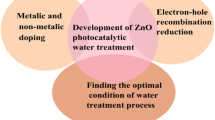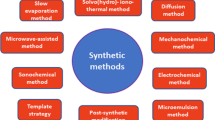Abstract
The selective capture of copper from strongly acidic solutions is of vital importance from the perspective of sustainable development and environmental protection. Metal organic frameworks (MOFs) have attracted the interest of many scholars for adsorption due to their fascinating physicochemical characteristics, including adjustable structure, strong stability and porosity. Herein, pz-UiO-66 containing a pyrazine structure is successfully synthesized for the efficient separation of copper from strongly acidic conditions. Selective copper removal at low pH values is accomplished by using this material that is not available in previously reported metal—organic frameworks. Furthermore, the material exhibits excellent adsorption capacity, with a theoretical maximum copper uptake of 247 mg/g. As proven by XPS and FT-IR analysis, the coordination of pyrazine nitrogen atoms with copper ions is the dominant adsorption mechanism of copper by pz-UiO-66. This work provides an opportunity for efficient and selective copper removal under strongly acidic conditions, and promises extensive application prospects for the removal of copper in the treatment for acid metallurgical wastewater.

Similar content being viewed by others
References
Ai K, Ruan C, Shen M, Lu L (2016). MoS2 nanosheets with widened interlayer spacing for high-efficiency removal of mercury in aquatic systems. Advanced Functional Materials, 26(30): 5542–5549
Awual M R (2019). Novel ligand functionalized composite material for efficient copper (II) capturing from wastewater sample. Composites Part B: Engineering, 172: 387–396
Brady D C, Crowe M S, Turski M L, Hobbs G A, Yao X, Chaikuad A, Knapp S, Xiao K, Campbell S L, Thiele D J, Counter C M (2014). Copper is required for oncogenic BRAF signalling and tumorigenesis. Nature, 509(7501): 492–496
Bui N T, Kang H, Teat S J, Su G M, Pao C W, Liu Y S, Zaia E W, Guo J, Chen J L, Meihaus K R, Dun C, Mattox T M, Long J R, Fiske P, Kostecki R, Urban J J (2020). A nature-inspired hydrogen-bonded supramolecular complex for selective copper ion removal from water. Nature Communications, 11(1): 1–12
Cao Y, Xiao W, Shen G, Ji G, Zhang Y, Gao C, Han L (2019). Carbonization and ball milling on the enhancement of Pb(II) adsorption by wheat straw: competitive effects of ion exchange and precipitation. Bioresource Technology, 273: 70–76
Cavka J H, Jakobsen S, Olsbye U, Guillou N, Lamberti C, Bordiga S, Lillerud K P (2008). A new zirconium inorganic building brick forming metal organic frameworks with exceptional stability. Journal of the American Chemical Society, 130(42): 13850–13851
Chen T, Liu F, Ling C, Gao J, Xu C, Li L, Li A (2013a). Insight into highly efficient coremoval of copper and p-nitrophenol by a newly synthesized polyamine chelating resin from aqueous media: competition and enhancement effect upon site recognition. Environmental Science & Technology, 47(23): 13652–13660
Chen X, Chen A, Zhao Z, Liu X, Shi Y, Wang D (2013b). Removal of Cu from the nickel electrolysis anolyte using nickel thiocarbonate. Hydrometallurgy, 133: 106–110
Chen Y, Pan B, Li H, Zhang W, Lv L, Wu J (2010). Selective removal of Cu(II) ions by using cation-exchange resin-supported polyethyleneimine (PEI) nanoclusters. Environmental Science & Technology, 44(9): 3508–3513
Choudhary M, Kumar R, Neogi S (2020). Activated biochar derived from Opuntia ficus-indica for the efficient adsorption of malachite green dye, Cu2+ and Ni2+ from water. Journal of Hazardous Materials, 392: 122441
Daliran S, Ghazagh-Miri M, Oveisi A R, Khajeh M, Navalón S, Âlvaro M, Ghaffari-Moghaddam M, Samareh Delarami H, García H (2020). A pyridyltriazol functionalized zirconium metal-organic framework for selective and highly efficient adsorption of palladium. ACS Applied Materials & Interfaces, 12(22): 25221–25232
Demiral H, Güngör C (2016). Adsorption of copper(II) from aqueous solutions on activated carbon prepared from grape bagasse. Journal of Cleaner Production, 124: 103–113
Feng H, Li Y, Luo D, Tan G, Jiang J, Yuan H, Peng S, Qian D (2016). Novel visible-light-responding InVO4-Cu2O-TiO2 tarnary nanoheterostructure: preparation and photocatalytic characteristics. Chinese Journal of Catalysis, 37(6): 855–862
Fitzgerald D J (1998). Safety guidelines for copper in water. The American journal of clinical nutrition, 67(5 Suppl): 1098S–1102S
Hosseinpournajjar E, Kianfar A H, Dinari M (2022). Synthesizing and characterization of Cu(II) polymer complex: application for removing heavy metals from aqueous solutions. Journal of the Iranian Chemical Society, 19(5): 1963–1977
Irving H, Williams R J P (1953). The stability of transition-metal complexes. Journal of the Chemical Society (Resumed), 3192–3210
Jiang C, Wang X, Wang G, Hao C, Li X, Li T (2019). Adsorption performance of a polysaccharide composite hydrogel based on crosslinked glucan/chitosan for heavy metal ions. Composites Part B: Engineering, 169: 45–54
Kuz’min V I, Kuz’min D V (2014). Sorption of nickel and copper from leach pulps of low-grade sulfide ores using Purolite S930 chelating resin. Hydrometallurgy, 141: 76–81
Lee S, Barin G, Ackerman C M, Muchenditsi A, Xu J, Reimer J A, Lutsenko S, Long J R, Chang C J (2016). Copper capture in a thioether-functionalized porous polymer applied to the detection of Wilson’s disease. Journal of the American Chemical Society, 138(24): 7603–7609
Lin S, Kumar Reddy D H, Bediako J K, Song M H, Wei W, Kim J A, Yun Y S (2017). Effective adsorption of Pd(II), Pt(IV) and Au(III) by Zr(IV)-based metal-organic frameworks from strongly acidic solutions. Journal of Materials Chemistry. A, Materials for Energy and Sustainability, 5(26): 13557–13564
Ma Y, Lu W, Han X, Chen Y, da Silva I, Lee D, Sheveleva A M, Wang Z, Li J, Li W, Fan M, Xu S, Tuna F, McInnes E J L, Cheng Y, Rudić S, Manuel P, Frogley M D, Ramirez-Cuesta A J, Schröder M, Yang S (2022). Direct observation of ammonia storage in UiO-66 incorporating Cu(II) binding sites. Journal of the American Chemical Society, 144(19): 8624–8632
Marcus Y (1988). Ionic radii in aqueous solutions. Chemical Reviews, 88(8): 1475–1498
Miniyar P B, Murumkar P R, Patil P S, Barmade M A, Bothara K G (2013). Unequivocal role of pyrazine ring in medicinally important compounds: a review. Mini reviews in medicinal chemistry, 13(11): 1607–1625
Park I, Tabelin C B, Jeon S, Li X, Seno K, Ito M, Hiroyoshi N (2019). A review of recent strategies for acid mine drainage prevention and mine tailings recycling. Chemosphere, 219: 588–606
Peng Y, Huang H, Zhang Y, Kang C, Chen S, Song L, Liu D, Zhong C (2018). A versatile MOF-based trap for heavy metal ion capture and dispersion. Nature Communications, 9(1): 1–9
Shao P, Liang D, Yang L, Shi H, Xiong Z, Ding L, Yin X, Zhang K, Luo X (2020). Evaluating the adsorptivity of organo-functionalized silica nanoparticles towards heavy metals: quantitative comparison and mechanistic insight. Journal of Hazardous Materials, 387: 121676
Wang D B, Chen B H, Zhang B, Ma Y X (1997). XPS study of aroylhydrazones containing triazole and their chelates. Polyhedron, 16(15): 2625–2629
Wang L, Shi Y, Yao D, Pan H, Hou H, Chen J, Crittenden J C (2019). Cd complexation with mercapto-functionalized attapulgite (MATP): adsorption and DFT study. Chemical Engineering Journal, 366: 569–576
Wang N, Feng J, Yan W, Zhang L, Liu Y, Mu R (2022). Dual-functional sites for synergistic adsorption of Cr(VI) and Sb(V) by polyaniline-TiO2 hydrate: adsorption behaviors, sites and mechanisms. Frontiers of Environmental Science & Engineering, 16(8): 1–14
Xie L, Yu Z, Islam S M, Shi K, Cheng Y, Yuan M, Zhao J, Sun G, Li H, Ma S, Kanatzidis M G (2018). Remarkable acid stability of polypyrrole-MoS4: a highly selective and efficient scavenger of heavy metals over a wide pH range. Advanced Functional Materials, 28(20): 1800502
Xu M, Meng S S, Liang H, Gu Z Y (2020). A metal-organic framework with tunable exposed facets as a high-affinity artificial receptor for enzyme inhibition. Inorganic Chemistry Frontiers, 7(19): 3687–3694
Yao Z, Shao P, Fang D, Shao J, Li D, Liu L, Huang Y, Yu Z, Yang L, Yu K, Luo X (2022). Thiol-rich, porous carbon for the efficient capture of silver: understanding the relationship between the surface groups and transformation pathways of silver. Chemical Engineering Journal, 427: 131470
Yu H, Shao P, Fang L, Pei J, Ding L, Pavlostathis S G, Luo X (2019). Palladium ion-imprinted polymers with PHEMA polymer brushes: role of grafting polymerization degree in anti-interference. Chemical Engineering Journal, 359: 176–185
Zhang X, Tong S, Huang D, Liu Z, Shao B, Liang Q, Wu T, Pan Y, Huang J, Liu Y, Cheng M, Chen M (2021). Recent advances of Zr based metal organic frameworks photocatalysis: energy production and environmental remediation. Coordination Chemistry Reviews, 448: 214177
Zhang Y, Xie Z, Wang Z, Feng X, Wang Y, Wu A (2016). Unveiling the adsorption mechanism of zeolitic imidazolate framework-8 with high efficiency for removal of copper ions from aqueous solutions. Dalton Transactions, 45(32): 12653–12660
Acknowledgements
This study was financially supported by the National Natural Science Foundation of China (Nos. 52125002 and 51908270), the Natural Science Foundation of Jiangxi Province (No. 20212ACB213006), and the National Key Research and Development Program of China (No. 2019YFC1907900).
Author information
Authors and Affiliations
Corresponding authors
Additional information
Highlights
• pz-UiO-66 was synthesized facilely by a solvothermal method.
• Efficient capture of copper from highly acidic solution was achieved by pz-UiO-66.
• pz-UiO-66 exhibited excellent selectivity and capacity for copper capture.
• Pyrazine-N in pz-UiO-66 was shown to be the dominant adsorption site.
Rights and permissions
About this article
Cite this article
Shao, J., Shao, P., Peng, M. et al. A pyrazine based metal-organic framework for selective removal of copper from strongly acidic solutions. Front. Environ. Sci. Eng. 17, 33 (2023). https://doi.org/10.1007/s11783-023-1633-0
Received:
Revised:
Accepted:
Published:
DOI: https://doi.org/10.1007/s11783-023-1633-0




